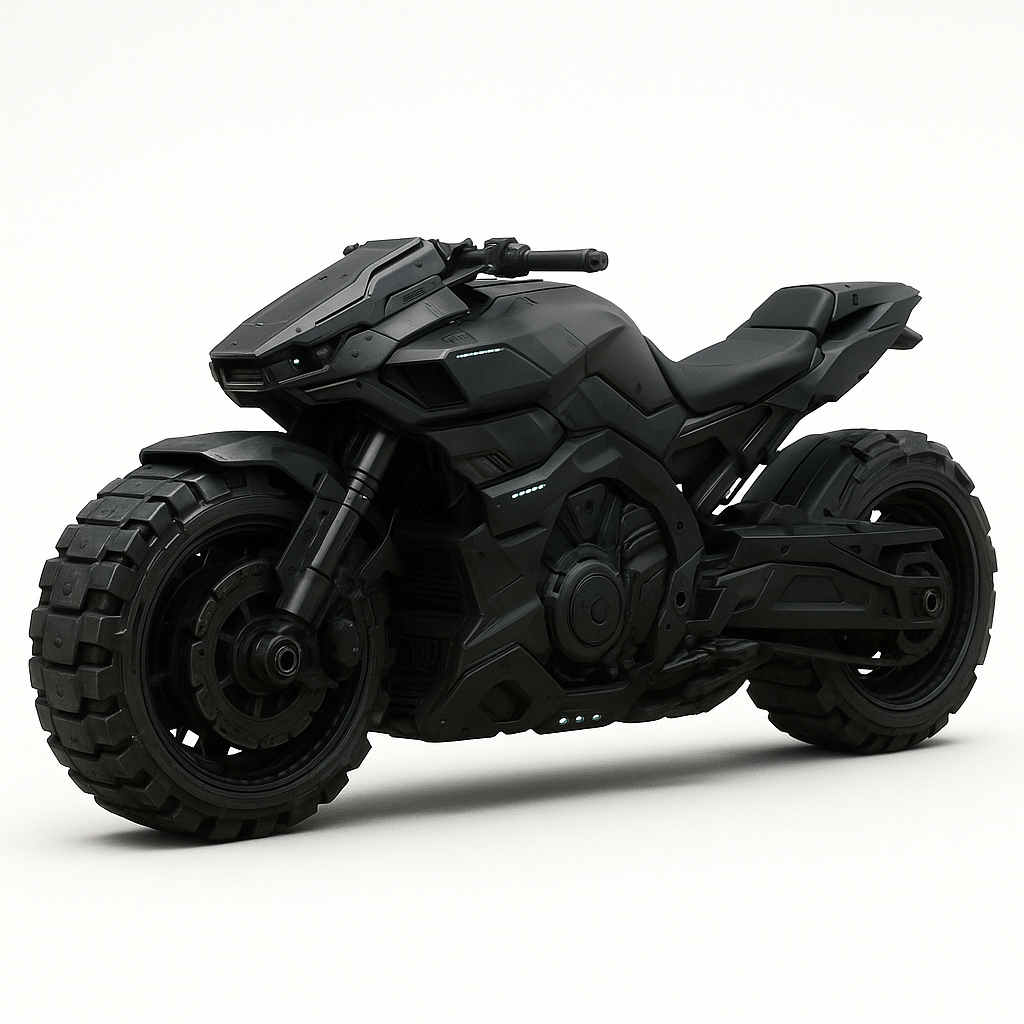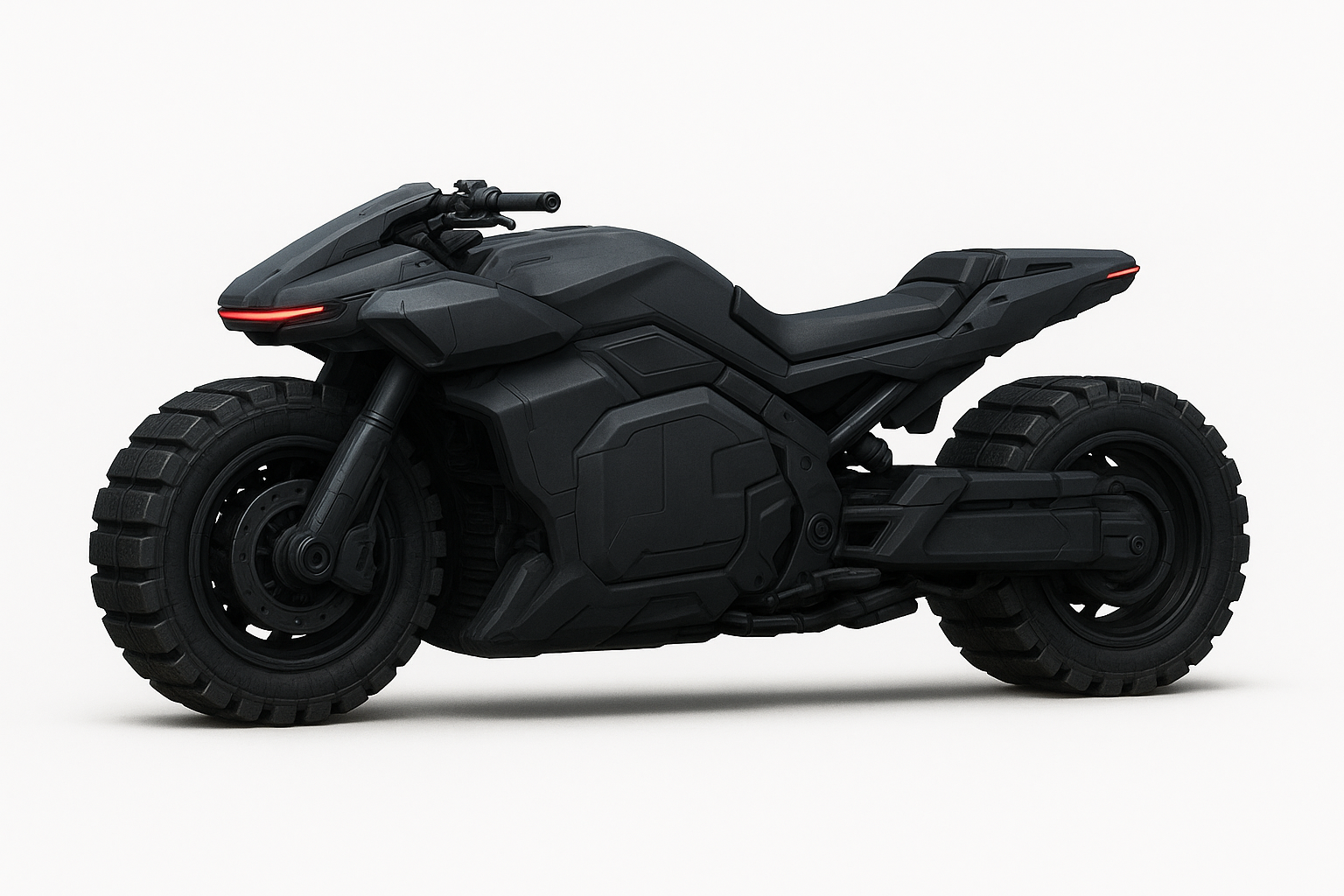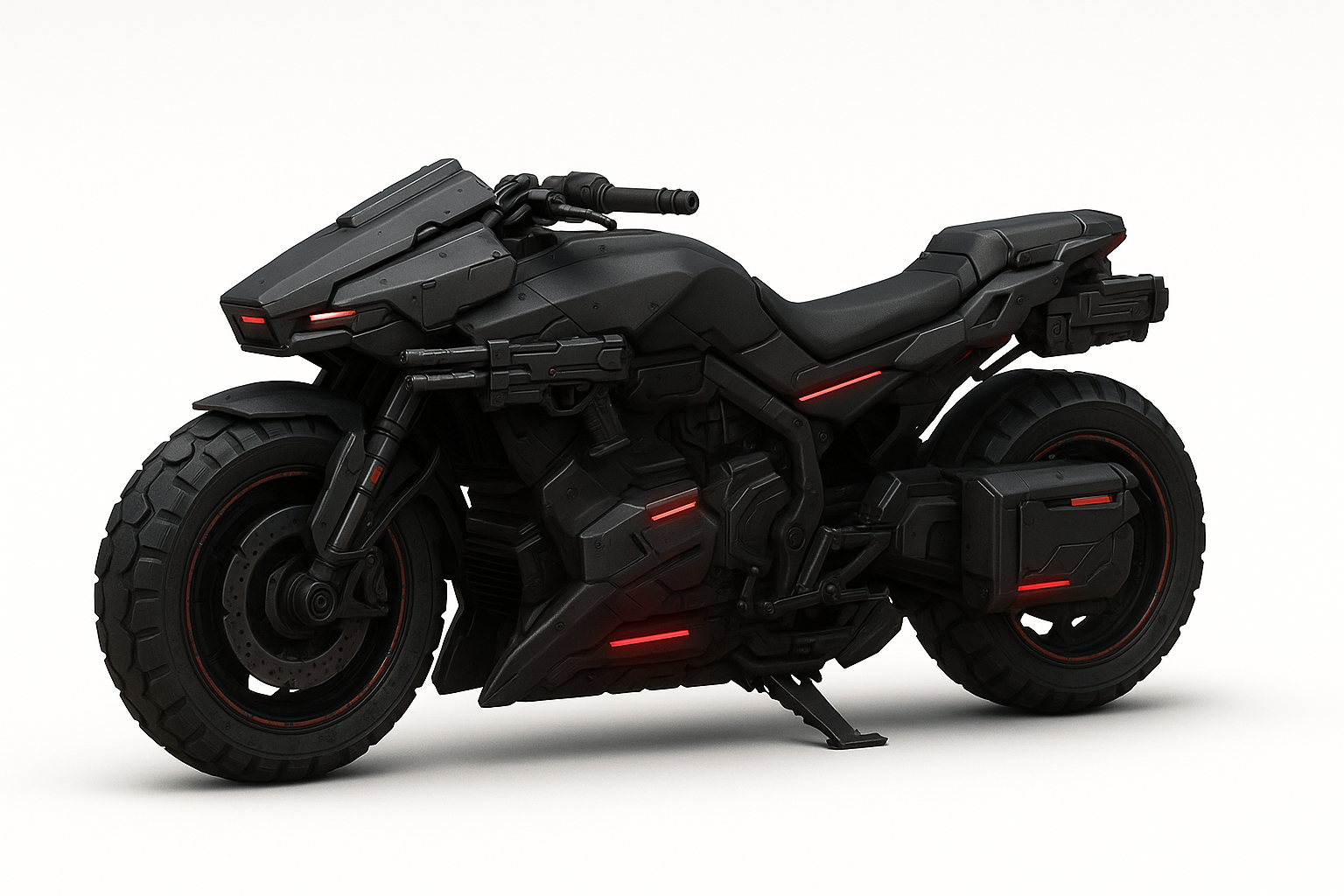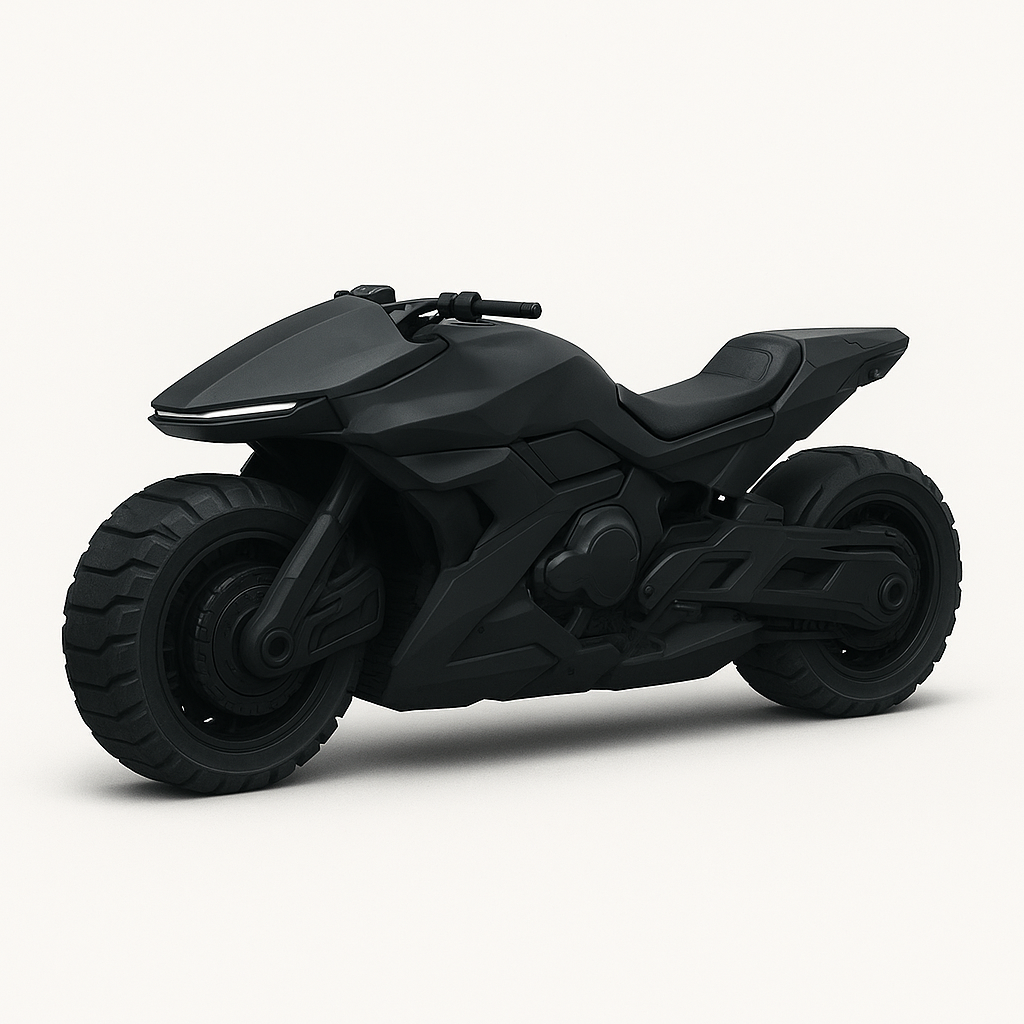VX-10 Revenant-Class Pursuit Bike
The VX-10 Revenant-Class Pursuit Bike, VX-10 Revenant, VX-10 RCPB, or simply Revenant, is the apex predator of urban mobility—engineered for speed, silence, and adaptability. Unlike hoverbikes or anti-grav vehicles, the Revenant maintains old-world traction through hardened, self-healing wheeled treads built to dominate broken infrastructure, vertical climbs, and razor-thin escape routes. With an ultra-low center of gravity, torque-responsive gyroscopic stabilizers, and neural-link interface compatibility, it handles like an extension of the rider’s reflexes.
Built for the urban battlefield of Thauzuno, the Revenant isn’t just a vehicle—it’s a survival rig, escape tool, and weapon platform all in one. Compact enough to weave through megacity slums, yet durable enough to slam through debris, barricades, or vehicle convoys, it is the motorbike of choice for enforcers, couriers, and high-risk extraction agents.
Design Features
The VX-10 Revenant's design is a masterclass in Vey’Zari engineering—aggressive, adaptive, and silent as a whisper in deep fog. Its chassis is sculpted from a single-block carbon-polymer monoframe reinforced with a tungsten-carbide flex-core, giving it both shock dispersion and armor-tier resilience without compromising on maneuverability. The surface finish is a matte anti-reflective coat embedded with micro-resonant filament strips that can dynamically modulate EM signatures to avoid drone tracking or sensor pings during high-risk transit. The frame's exo-skeletal contours aren't merely aesthetic; they channel airflows at high speeds, disperse thermal bleed from the fusion cell, and offer a series of tactical hardpoints for modular attachments such as signal scramblers, anti-drone netcasters, or disposable cache pods.
The wheels are perhaps its most defining feature—omni-grip adaptive treads that sense and respond to terrain in real time. Their outer layer is composed of a programmable rubber-alloy compound with crystalline memory mesh that adjusts surface friction down to the micrometric level. This allows the bike to operate with flawless traction on shattered ferrocrete, acid-pitted alleyways, or blood-slicked walkways. Hidden beneath each wheel is a subcore ring of interlocking high-density composites designed to take over traction control in the event of tread damage, allowing the Revenant to maintain operability even after partial destruction—a feature most often credited with saving operatives mid-pursuit. Gyro-stabilizers are housed deep in the frame’s belly, tied directly into a reflex engine that interprets rider input at the neuromuscular level. Whether linked to neural implants or operated via precision handlebars, the bike senses every twitch, lean, and gaze-direction as tactical intent, responding faster than conscious thought. Cornering on a Revenant feels like gliding through a different kind of gravity—it leans without skidding, counterbalances without delay, and can even vault off impact surfaces if the rider engages the vertical pivot boosters at just the right angle.
The onboard control interface is deceptively minimalist: a holographic dash that materializes on rider presence, showing speed, ammo status (if armed), power core health, route overlays, and syndicate-linked alerts. Riders with neural implants can bypass this entirely, controlling every system by raw mental impulse. A secondary AI-driven co-pilot module, nicknamed “Whisper,” manages background tasks such as trajectory analysis, threat prediction, and blackout pathfinding in real time, even capable of issuing warning pulses directly into a rider’s neural link if sudden threats are detected. Lighting is subtle, functional, and full of layered communication. Narrow strips of micro-LEDs wrap the contour lines of the bike’s frame, capable of switching to encrypted glow-signals—used by syndicates to silently communicate intention, authorization, or distress in active zones. These glow-codes are color-coded and pulse-timed, often only decipherable by trained eyes or matching AI protocols. The rear compartments are seamless and flush with the frame until activated, revealing dual storage bays with smart-lock mag-seals. One is typically used for tools, encrypted data cores, or collapsible weapons; the other, often customized by the rider, may contain emergency trauma kits, spare neurocapsules, or a secondary identity packet. On combat-configured variants, hidden side-panel recesses deploy dart pods, countermeasure smokes, or even single-use microdrone hives.
Every aspect of the Revenant’s build echoes the Vey’Zari doctrine: survive the ambush, finish the job, disappear without a trace. The bike doesn’t simply carry its rider—it amplifies them, conceals them, and when needed, defends them. Some operatives say the Revenant feels alive, that after enough rides, it begins to anticipate your decisions before you make them. Others claim the opposite—that once you’ve bonded with a Revenant, you don’t ride it. You become it.
Variants
The VX-10S “Shadowline” is the stealth-focused configuration, stripped of all non-essential emissions and engineered for black-ops infiltration, courier runs under blackout conditions, and silent surveillance missions deep in hostile territory. Its engine signature is dampened to sub-audible frequencies, and the thermal shroud coating renders it virtually invisible to most standard detection systems. The Shadowline also incorporates phase-masking field emitters that subtly bend low-light wavelengths, making it difficult to track visually even when moving. Its tires are whisper-threaded to minimize sound, and its hover-assist nodes activate only in emergency stabilization—ensuring noise discipline is maintained at all times. Only high-tier Black Echo operatives are issued the Shadowline, and even fewer are permitted to modify it. Rumors persist that some units have onboard AI copilots capable of autonomously completing missions if the rider is terminated.
The VX-10R “Razorcoil” is built for warzone penetration and crowd suppression. This variant sports integrated side panniers housing retractable micro-dart launchers capable of delivering neurotoxins, tracers, or plasma charges. Its undercarriage conceals mono-blade vanes that deploy at speed, allowing the rider to perform devastating close-passes—disemboweling ground troops or slicing enemy tires with surgical precision. A modular hardpoint above the front wheel can support a compact pulse rifle, grapple spool, or flame arc projector depending on mission needs. Its frame is reinforced for ramming and features adaptive shock control that lets the rider slam through barricades without losing control. Razorcoil units are often seen leading syndicate breach squads or pursuing fugitives across the underlevels, their presence signaled by the distinctive low-pitched whir of armored tread and the flickering crimson arc-lights lining their flanks.
The VX-10C “Courier Spec” is a sleek, stripped-back variant engineered for high-speed logistical transfers under hostile conditions. It sacrifices weapon systems in favor of reinforced cargo architecture and high-output performance tuning. The dual-compartment cargo vault is lined with reactive alloy mesh and shielded from electromagnetic interference, capable of housing high-risk data cores, volatile compounds, or classified biomatter samples. Dual biometric locking systems require two authorized signatures to access its contents, and an emergency purge protocol can incinerate the compartment in under 0.6 seconds if tampering is detected. Courier Specs are favored by datarunners, underground med-distribution cells, and syndicate diplomats moving sensitive material between factions. Some units are equipped with decoy beacons or counter-pursuit foggers to disorient trackers, and elite couriers often personalize their bikes with high-performance tuning chips, custom stabilizers, and non-standard paint schemes used as both camouflage and signature.
There are also unofficial or black-market variants that have emerged from captured units or rogue engineers. One such rumored build is the VX-10F “Feralskin”, an outlaw configuration cannibalized from multiple models, coated in salvaged plating and powered by unstable overclocked cores. Feralskins are loud, fast, and brutal—favored by freelance raiders and exile hunters who care more about raw power than finesse. These units rarely last more than a few years before burning out or detonating, but in that time, they carve out reputations soaked in oil, fire, and notoriety.
Cultural Use
Within Vey’Zari society, the VX-10 Revenant is far more than a vehicle—it is an extension of one’s identity, autonomy, and survival ethos. In the eyes of the syndicates and the sprawl alike, owning a Revenant isn’t just about transportation—it’s a declaration: that you are fast enough to escape, skilled enough to maneuver, and dangerous enough to need such a machine. Among street operatives, courier guilds, and rogue freelancers, the Revenant is often viewed as a rite of passage; many are gifted their first frame by a mentor, crew, or syndicate upon completing their first live contract. In others, it must be stolen or claimed from a downed rival—making it a blood-earned asset whose very possession marks the rider as a survivor.
Revenant customization is as much personal philosophy as practical necessity. Riders often modify their bikes to reflect their operational focus—suppressor panels for silence specialists, hardened treads for demolitionists, or integrated glyph projectors for high-visibility enforcers. The most elite operatives encode moving kill-records or encrypted reputation markers into their chassis lighting patterns, readable only by neural-linked observers. Others etch memory-glyphs or oath-symbols into the internal frame—hidden beneath armor plating—marking loyalty pacts, vendettas, or fallen comrades. Every scratch on a Revenant tells a story, and within the culture, to ride a heavily weathered model is to wear your past like armor.
Revenants also play a subtle but crucial role in syndicate diplomacy. In some cases, arriving on a customized Revenant signals status and confidence during power-broker meetings or contract arbitrations. Certain variants—especially the ultra-rare Shadowline customs—are considered tokens of high favor, granted only by syndicate leaders or earned through debt-clearing missions of exceptional difficulty. To gift a Revenant is to offer not only trust, but a piece of one’s reputation—an act rarely done lightly. On the flip side, destroying someone’s Revenant, especially if it is neural-linked or glyph-marked, is seen as a personal attack akin to mutilation. Entire blood feuds have been sparked by the deliberate sabotage or theft of a Revenant bike. Even among non-affiliated Vey’Zari, the sound of a Revenant’s approach carries weight. Its unique sonic footprint—barely more than a whisper to those trained to hear it—can trigger panic, awe, or reverence depending on who’s riding. In the Lower Zones, children mimic Revenant riders in street games, and gangs may tattoo stylized bike frames onto their skin as symbols of speed, escape, or raw willpower. Urban myth speaks of riders who became legends—operatives who dodged rooftop drones, leapt burning barricades, or outpaced missile locks through back-alley gravity drops—each story reinforcing the bike’s mythos as the ultimate extension of Vey’Zari agility and defiance. Among older enclaves, particularly those with roots in pre-syndicate honor traditions, the Revenant has taken on almost totemic significance. Some see it as a symbol of the path-walker, the one who moves between warzones, contracts, and betrayals with nothing but skill and momentum to protect them. In this view, a Revenant is not just a machine—it is a living momentum, a promise to never stop moving until the mission is complete, the debt is paid, or the name is remembered.
To own one is to be seen. To ride one is to be heard, even in silence. And to master one is to never be caught.
VX-10 Revenant
Production Information
Type
High-Performance Motorbike
DesignationUrban Interceptor/Syndicate Courie/Combat Pursuit
ManufacturerDrahvoss Mobility Systems (black-licensed to multiple syndicates)
Vehicle CostⱽҜ23,500 (standard)
- ⱽҜ28,275 (Shadowline)
- ⱽҜ56,580 (Razorcoil)
- ⱽҜ15,230 (Courier Spec)
Technical Information
Length
2.9 meters (9.5 feet)
Weight334 kg (736.3lb.) (unladen)
Max Speed180 km/h (111.8 mph)
Acceleration0–80 km/h in 2.3 seconds
Drive SystemDual rear-wheel kinetic-drive hub motors; reinforced with torque-balanced gyros
Fuel SourceHybrid microfusion cell + kinetic regenerator (self-charging during motion)







Comments